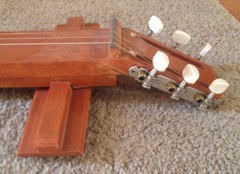GAA's Silent Dobro

Introduction
This Silent Dobro was inspired by the Yamaha
Silent Guitar. I wanted a way to practice my dobro playing without disturbing anyone. I wanted something that could be packed in a suitcase and taken on trip. An electric lap steel would come close to satisfying my requirements. However, it wouldn't be as portable and it might be difficult to find one that has the exact scale and string spacing of my dobro.
Construction
Construction is pretty simple. The wood is from a flatsawn 1x3 poplar board from the local home improvement store. The board's finished dimensions were 3/4" x 2-1/2".

The body is primarily one long section of the 1x3 board. There are two strips along the bottom that are 1/2" tall and 3/4" wide. Their grain is oriented perpendicular to the grain of the main body. They reinforce the body and keep it from warping (see the Modifications section below).
The scale length, string spacing and string height match that of my dobro (see Dobro Measurements below). The tuners are located at the tail end rather than the head end to keep it from being top heavy. The strings go through the body at the head. The total length is 31" - it extends 1" beyond the nut at the head and 5" beyond the saddle at the tail. The body is 2-1/2" wide from the 12th fret to the tail of the body. The body tapers slightly from the 12th fret to the nut.
The nut is 3/4" wide at the base and tapers to 1/2" at the top. The "bridge" is 1/2" wide from bottom to top. The nut and bridge are capped with a scrap piece of ebony. I figured ebony is slicker and harder than poplar so it won't wear as quickly.
I used a router to taper the body. The slotted headstock was done by drilling a row of holes with a 1/4" drill bit then using a chisel and rasp to turn them into a slot.
The body is stained then finished in polyurethane. The unfinished poplar had poorly defined grain and a slightly greenish hue. I tried a couple of different stains before I found one that looks good on the poplar. For now the fretboard is paper until I can decide what goes well with the body color.
Note that the scale length is the same but the total string length is slightly shorter than that of a dobro. I don't have to buy strings for it - just use the old set when I change the strings on my dobro!
Modifications
Originally the body was a single length of 1x3. When I tuned it up to pitch the string tension created a noticeable warp in the board. I might have avoided this by using thicker quartersawn wood or adding a metal reinforcing bar. I solved the problem by ripping a length of the poplar board into two 1" wide strips, rotating them so the grain was oriented perpendicular to the original flatsawn body grain and attaching them to the bottom of the body. The strips are attached with glue and screws. Later I trimmed the strips down to be 1/2" in height so the body isn't as tall.
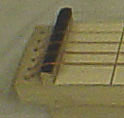
|
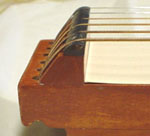
|
Originally the nut was 1/2" wide like the bridge. However, there is quite a bit of torque on the nut because of the sharp angle of the strings coming off of the it and it developed a slight tilt. I made a new nut with a wider base to make the glued surface area larger so the attachment would be stronger. |
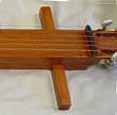
|

|
The short cross piece near the tail was added afterwards. Originally the body had a tendency to wobble when picking hard. The cross piece gives it some stability. It also makes a nice carrying handle. It is held in place with a wingnut and can be removed when packing it for travel. At first the cross piece was simply a 3/4" wide piece of wood. Later I added a 2-1/2"x1/4" piece of wood to the base for even more stability. |
Conclusions
It was an easy project. It's fun to play. The solid body is resonant enough that I can hear my playing without any amplification. It's fine for practicing rolls, scales, slants, etc. It's not as useful for working on my tone since soundwise it's pretty different than a dobro.
I've considered adding a raised cover over the bridge similar to the strap on a dobro coverplate. It would give me a place to rest my hand and make the position of my hand more like the position it's in when I'm playing a real dobro.
There are two items on my TBD list:
- an extension so I can attach a strap and play it standing up
- a small built-in compartment to hold the fingerpicks and slide
Followup Project - A Mini Practice Dobro
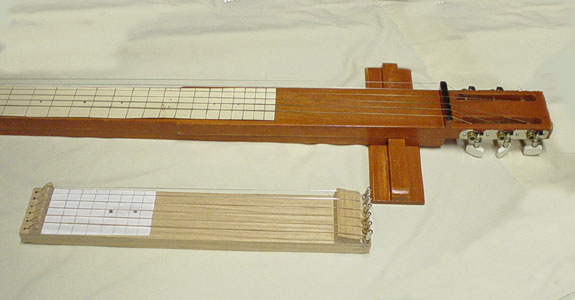
After building the Silent Dobro I decided to build an even simpler, more compact version. This has a 12-1/2" scale. The scale is exactly half the length of my dobro's scale but it's tuned an octave higher so the string tension is the same. However, it feels much "stiffer" because of the shorter scale. The string spacing matches that of my dobro with the spacing at the nut the same as my dobro's spacing at the 12th fret.

|
It's made out of a 1x3 piece of red oak. The body is simply a length of the 1x3. I used inexpensive dulcimer tuning pins (only $1.80 for 6 pins, but you'll need to buy a $5 square socket tuning wrench). The tuning is pretty stable so the tuning pins work fine. If I were to make a "pro" version I'd probably use regular tuners. I'd also use ebony on the saddles since the strings are showing a tendency to dig into the oak saddles. |
When I built this I just wanted something for practicing rolls. But to my surprise, it's pretty fun to play. It has a cute sound, somewhat like an autoharp or a "toy piano". The extremely short scale makes doing slants and zipping from fret to fret a breeze - I play more freely when playing this instrument. It takes up very little space and is very solid. I leave it lying around so it's always available to pick up and play when the mood strikes. It's handy for working out tunes on the dobro.
Dobro Measurements
Here are measurements taken off my Crafters of Tennessee dobro:
- The nut is 3/16 thick by 1-31/32 wide.
- Scale is 25". Fretboard extends to the 20th fret and is approximately 17-1/8" long.
- The portion of the metal coverplate that covers the saddle is 2-3/4" long by 1" wide and is 3/8" above the strings.
- Distance from the nut to first tuner post is about 2".
- Distance from saddle to the string holes in the tailpiece is 3".
| Measurement | At the nut | At the 12th fret | At the saddle |
|---|---|---|---|
| Fretboard width | 2" | 2-1/4" | - |
| String Spacing | 1-3/4" | 2" | 2-3/8" |
| String Height | 1/2" | 15/32" | 13/32" |
Links
- There are other commercially available "silent" instruments besides the Yamaha Silent Guitar. Yamaha also makes a Silent Violin, Cello and Bass. RIGA has the Solids line of silent instruments (guitar, ukulele, mandolin and banjo). SoloEtte makes silent nylon and steel string guitars.
- If you're interested in building instruments, visit the Musical Instrument Makers Forum. It's a valuable source of information and advice. If you find it useful you should consider becoming a paying subscriber.
Feel free to contact me if you have any questions or comments. Visit my home page for other instrument building pages.
visits since July 6, 2003
Updates:
07/06/03 - Initial version
08/31/03 - Added description of additional modifications
10/13/03 - Added description of the Mini Practice Dobro
11/14/03 - Minor editorial changes
04/03/06 - Moved to new server
11/16/13 - Added pic and description of new head angle
